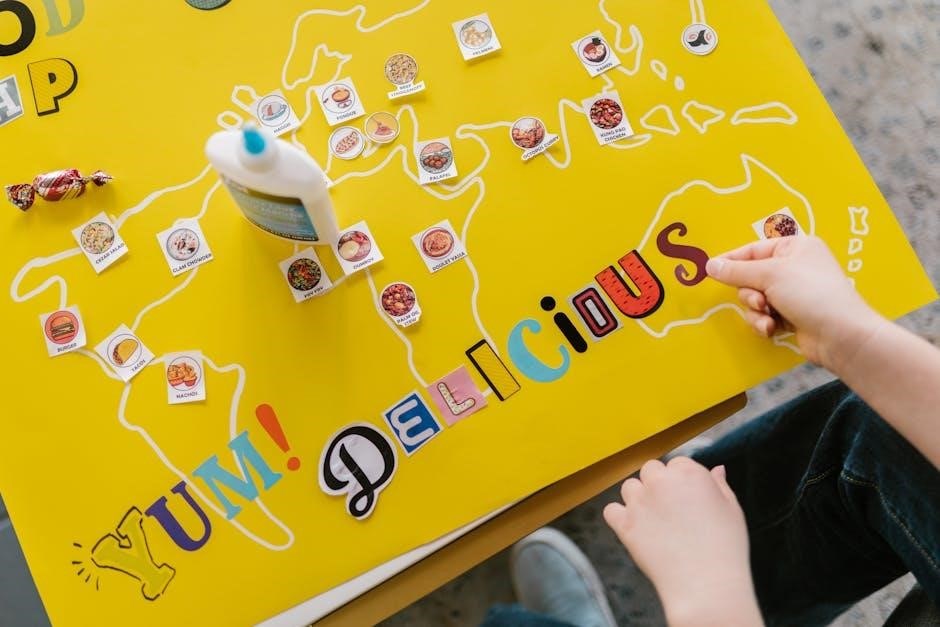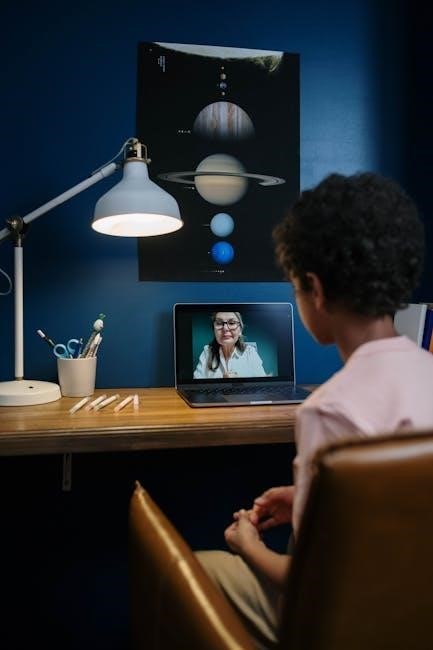
The Solar System is a fascinating collection of planets, moons, and celestial bodies orbiting the Sun. It includes eight planets, dwarf planets, asteroids, and comets, offering endless learning opportunities for kids. The Sun, as the central star, provides light and energy, making life possible. Each planet is unique, from Mercury’s proximity to the Sun to Neptune’s icy vastness. Exploring the Solar System helps children understand astronomy, science, and the universe’s wonders.
1.1 What is the Solar System?
The Solar System is a collection of celestial objects, including planets, moons, asteroids, and comets, that orbit around the Sun. It is named after the Latin word “Sol,” meaning Sun, as it is the central star. The system includes eight planets, each with unique features, from Mercury’s closeness to the Sun to Neptune’s icy vastness. Dwarf planets, like Pluto, and other smaller bodies also exist. The Solar System formed over 4.5 billion years ago and continues to captivate scientists and children alike. Understanding it helps kids explore astronomy, science, and the universe’s many mysteries through engaging resources like books, worksheets, and interactive tools.
1.2 Why is the Sun Important?

The Sun is the heart of our Solar System, providing light, heat, and energy to all planets. Without it, life on Earth would not exist. The Sun’s gravity keeps planets in orbit, maintaining the system’s balance. It powers photosynthesis, essential for plant growth, and influences Earth’s climate and weather. The Sun’s energy also drives renewable resources like solar power. For kids, learning about the Sun’s importance connects them to science and the environment. Fun facts, like the Sun being 93 million miles away, make it engaging. Educational tools and worksheets help children explore the Sun’s role in a fun, interactive way.
1.3 How Many Planets Are There?
Our Solar System consists of eight planets, each unique in size and features. Mercury, Venus, Earth, Mars, Jupiter, Saturn, Uranus, and Neptune orbit the Sun. Pluto, once classified as the ninth planet, is now considered a dwarf planet. The planets vary greatly, from Mercury’s proximity to the Sun to Neptune’s icy distance. Learning about the planets helps kids understand their differences and the Solar System’s structure. Fun facts and interactive activities, like labeling exercises, make learning engaging. These resources, often found in educational PDFs, help children explore the planets in an exciting and educational way, fostering a love for astronomy and science.

The Sun and Its Role
The Sun is the center of our Solar System, providing light and energy to the planets. It powers life on Earth and influences planetary orbits and climates.
2.1 The Sun as the Center of the Solar System
The Sun is the heart of our Solar System, the largest object, and the primary source of light and energy. All planets and celestial bodies orbit around it due to its immense gravitational pull. The Sun’s energy is essential for life on Earth, powering photosynthesis and shaping climates. Its influence determines the orbits of planets, affecting their temperatures and environments. Understanding the Sun’s role helps kids grasp how our Solar System functions. Educational resources, like books and activities, often highlight the Sun’s importance, making it a key topic for young learners to explore and appreciate.
2.2 How the Sun Affects the Planets
The Sun’s immense gravitational pull keeps the planets in their orbits, ensuring they revolve around it. Its energy powers the climates and seasons on Earth, while its absence creates extreme cold on distant planets like Neptune. The Sun’s ultraviolet and X-ray emissions influence planetary atmospheres, like Venus’s thick clouds and Mars’s thin air. Mercury, being closest, endures scorching temperatures, while Saturn’s rings are shaped by the Sun’s light. Educational resources, such as books and worksheets, help kids explore these effects, making the Sun’s role in the Solar System a vital topic for young learners to understand and appreciate.
2.3 Fun Facts About the Sun
The Sun is about 4.6 billion years old and is made mostly of hydrogen and helium. It is so massive that it makes up 99% of our Solar System’s mass! The Sun’s surface temperature is about 5,500°C, but its core is a staggering 15 million°C. It takes eight minutes for sunlight to reach Earth. The Sun is so bright that it is the only star we can see from Earth during the day. Fun activities, like solar system puzzles and coloring pages, can help kids learn these amazing facts. The Sun is truly a star that makes life on Earth possible!

The Planets in Our Solar System
The Solar System includes eight planets, each unique and fascinating. From Mercury to Neptune, they vary in size, temperature, and features, offering endless learning opportunities for kids.
3.1 Mercury: The Closest Planet to the Sun
Mercury is the smallest planet in our Solar System and the closest to the Sun. It is a rocky planet with a heavily cratered surface. Mercury has no moons and orbits the Sun very quickly, taking just 88 days to complete one rotation. The planet has extreme temperatures, with daytime highs reaching up to 800°F (427°C) and nighttime lows dropping to -290°F (-179°C); Despite these conditions, Mercury is a fascinating world to learn about, offering insights into the early formation of the Solar System. Its proximity to the Sun makes it a unique subject for studying celestial mechanics and planetary science.
3.2 Venus: The Hottest Planet
Venus is often called Earth’s twin because of their similar size, but it’s also the hottest planet in the Solar System. Its thick atmosphere, made mostly of carbon dioxide, traps heat in a runaway greenhouse effect. Surface temperatures can reach up to 870°F (465°C), hot enough to melt lead. Venus has no moons and rotates very slowly, taking 243 Earth days to complete one rotation. It’s also the only planet that spins clockwise. Despite its hostile environment, Venus has volcanoes and mountains, showing it’s geologically active. The thick clouds of sulfuric acid and sulfur dioxide make it a fascinating yet alien world for kids to explore.

3.3 Earth: Our Home Planet
Earth is the only known planet in the universe where life exists. It’s the third planet from the Sun and has the perfect distance to support life. Earth’s atmosphere is rich in oxygen and nitrogen, and it’s covered by 71% water, including oceans, lakes, and rivers. The planet has seven continents and one moon. Earth’s surface is diverse, with mountains, forests, and deserts. It takes 365 days to orbit the Sun and 24 hours to complete one rotation. Earth’s unique balance of resources makes it a special place in our Solar System, and it’s where we call home.
3.4 Mars: The Red Planet
Mars, known as the Red Planet, is a rocky planet with a reddish appearance due to iron oxide in its soil. It is smaller than Earth and has a thin atmosphere. Mars has two moons, Phobos and Deimos, and is home to the largest volcano in the Solar System, Olympus Mons. The planet has polar ice caps and vast deserts. Scientists believe Mars may have had water and possibly life in the past. Today, robots like Perseverance and Curiosity explore Mars to learn more about its history and potential for future human visits. Mars is a fascinating planet that captures the imagination of many space enthusiasts.
3.5 Jupiter: The Largest Planet
Jupiter is the largest planet in our Solar System, with a diameter bigger than Earth’s. It’s a gas giant, mostly made of hydrogen and helium. Jupiter has a famous Great Red Spot, a giant storm that has lasted centuries. The planet has dozens of moons, with Io, Europa, Ganymede, and Callisto being the largest. Jupiter’s magnetic field is very strong, and it has beautiful colorful clouds. Scientists study Jupiter to learn more about how planets form and evolve. Its size and unique features make Jupiter one of the most fascinating planets for kids to explore and learn about in the Solar System.

3.6 Saturn: The Planet with Rings
Saturn is one of the most recognizable planets because of its stunning rings. These rings are made of ice and rock particles and stretch out for hundreds of thousands of miles. Saturn is a gas giant, like Jupiter, and has many moons. Its largest moon, Titan, is one of the few moons in the Solar System with a thick atmosphere. Saturn’s rings are divided into sections with gaps, like the Cassini Division. Scientists think the rings are pieces of moons that never came together to form a full moon. Saturn’s beauty and unique features make it a favorite for kids to learn about and explore in the Solar System.
3.7 Uranus: The Tilted Planet
Uranus is known as the tilted planet because it spins on its side, with a 98-degree axial tilt. This unique rotation causes extreme seasons, making it one of the most fascinating planets. Uranus is an ice giant, mostly made of water, ammonia, and methane ices, with a small rocky core. Its thick atmosphere, mostly hydrogen and helium, gives it a blue-green color. Uranus has a system of rings and moons, with Miranda being one of the most interesting moons due to its unique geological features. The planet’s magnetic field is also highly tilted, adding to its mysteries. Uranus is an exciting planet for kids to learn about, offering many unique features that set it apart in our Solar System.
3.8 Neptune: The Farthest Planet
Neptune is the farthest planet from the Sun, making it the coldest in the Solar System. It is an ice giant, composed mostly of water, ammonia, and methane ices, with a small rocky core. Neptune’s atmosphere is mostly hydrogen and helium, and its strong winds create massive storm systems, like the Great Dark Spot. The planet has a magnetic field and a system of rings and moons. Its moon, Triton, is unique because it orbits Neptune backward and has geysers that shoot ice particles into space. Neptune’s deep blue color and extreme weather make it a fascinating planet for kids to explore and learn about in the Solar System.

Educational Resources for Kids
Educational resources like books, worksheets, and interactive tools make learning about the solar system fun and engaging for children. These materials are designed to spark curiosity and creativity.
4.1 Solar System Books for Children
Solar system books for children are an excellent way to introduce kids to astronomy. These books are designed to be engaging and educational, with colorful visuals and simple language. Many are available as PDFs, making them accessible for digital learning. Popular titles include The Magic School Bus Lost in the Solar System and National Geographic Kids Ultimate Space Atlas. These books often feature fun facts, quizzes, and activities to keep young learners entertained. They also cater to different age groups, ensuring that children can explore the solar system at their own pace. These resources are perfect for sparking curiosity and fostering a love for science in kids.
4.2 Solar System Worksheets and Activities
Solar system worksheets and activities are fantastic tools for interactive learning. These resources, often available as PDFs, include crossword puzzles, word searches, and matching games that teach planet names, orbital patterns, and fun facts. Activities like labeling diagrams or sequencing the planets help reinforce learning. Many worksheets are designed with colorful visuals and simple language, making them ideal for young learners. They also encourage critical thinking and creativity, while keeping kids engaged. These materials are perfect for both homeschooling and classroom use, offering a hands-on approach to understanding the solar system. They complement books and games, providing a well-rounded educational experience for children.
4.3 Interactive Tools for Learning
Interactive tools for learning about the solar system make education fun and engaging for kids. These tools, often available in PDF formats or online platforms, include quizzes, puzzles, and games that test knowledge and encourage exploration. Some tools feature animations, like virtual tours of the planets or simulations of orbital movements. Others offer drag-and-drop activities, where kids can arrange planets in order or match facts with images. Videos and audio clips also enhance learning by providing visual and auditory experiences. These interactive tools cater to different learning styles, making the solar system more accessible and exciting for children. They are perfect for supplementing traditional lessons and fostering a deeper interest in space.
4.4 Solar System Mini-Books for Kids
Solar system mini-books for kids are a great way to introduce young learners to the wonders of space. These compact books, often available in PDF formats, are designed with colorful illustrations and simple language, making them perfect for early readers. They typically include fun facts about planets, stars, and the Sun, along with labeled diagrams and activity pages. Mini-books are portable and easy to use, allowing kids to explore the solar system at their own pace. Many mini-books also include interactive elements, such as mazes or word searches, to keep children engaged. They are ideal for classrooms, homeschooling, or bedtime reading, sparking curiosity and creativity in young minds while teaching them about the universe.

Fun Activities to Learn About the Solar System
Engage kids with hands-on solar system activities like DIY models, coloring pages, and labeling exercises. These interactive tools make learning about planets and stars exciting and memorable for children.
5.1 DIY Solar System Models
Creating DIY solar system models is a fun and educational activity for kids. Using materials like Styrofoam balls, paint, and cardboard, children can craft scale models of planets and the Sun. This hands-on project teaches them about the relative sizes and distances between celestial bodies. Kids can paint the planets in their unique colors and assemble them to visualize the Solar System. DIY models also help kids understand the concept of orbit and gravity in an engaging way. Encourage creativity by adding details like rings for Saturn or red hues for Mars. This activity fosters learning and sparks curiosity about space. Kids will enjoy displaying their finished models proudly!
5.2 Solar System Coloring Pages
Solar System coloring pages are an engaging way for kids to learn about planets and celestial bodies. These pages feature illustrations of planets, stars, and spacecraft, allowing children to explore colors while gaining knowledge. Coloring helps develop fine motor skills and creativity. Many PDF resources offer detailed images, such as Saturn’s rings or Jupiter’s Great Red Spot. Kids can also learn about the relative sizes and positions of planets. Coloring pages often include fun facts, making learning interactive. Parents and teachers can print these pages for educational activities. They are perfect for classroom use or homeschooling, making space education fun and accessible for young learners.
5.3 Planetary Labeling Exercises
Planetary labeling exercises are a great way for kids to learn the names and order of the planets. These activities typically include diagrams of the Solar System with blank spaces for labeling. Children can match planet names to their corresponding images, reinforcing memory and recognition. Many PDF resources provide colorful, engaging layouts that make learning fun. These exercises also help kids understand the relative positions of planets from the Sun. Labeling activities improve cognitive skills and hand-eye coordination. They are ideal for classrooms or homeschooling, offering an interactive way to explore the Solar System. Parents can print these exercises for a hands-on learning experience that fosters curiosity and knowledge retention.
5.4 Solar System Puzzles and Games
Solar System puzzles and games are engaging tools for kids to learn about planets and their features. Jigsaw puzzles of the Solar System help children recognize planet shapes and relative sizes. Word searches, crosswords, and matching games reinforce planet names and facts. Interactive games like “Pin the Ring on Saturn” or “Solar System Scavenger Hunts” make learning dynamic. These activities, often found in PDF formats, promote problem-solving skills and spatial awareness. They also encourage teamwork when played with others. Puzzles and games make complex concepts fun, helping kids retain information and develop a lifelong interest in astronomy. They are perfect for both individual and group learning environments.

Solar System Safety and Events
Exploring the Solar System involves safety, especially during eclipses. Use certified glasses for viewing. Learn about meteor showers and planetary alignments safely with adult supervision always.
6.1 Viewing Solar Eclipses Safely
Viewing solar eclipses is thrilling, but safety is crucial. Never look directly at the Sun during an eclipse, as it can harm your eyes. Use certified solar viewing glasses that meet international safety standards, like ISO 12312-2. These glasses filter out harmful UV and IR rays, protecting your eyes. Supervise children closely to ensure they use the glasses correctly. A pinhole projector is another safe option, allowing you to watch the eclipse indirectly. Regular sunglasses are not protective enough. Always prioritize eye safety and enjoy this rare celestial event responsibly. Remember, eye protection is essential for everyone, including children;
6.2 Making Solar Eclipse Glasses
Making solar eclipse glasses is a fun and educational activity for kids. Start with sturdy cardboard frames or purchase plain glasses. Attach ISO 12312-2 certified solar viewers or lenses to the frames. These lenses are specifically designed to block harmful UV and IR rays. Cut the lenses to fit the frames and secure them with glue or tape. Decorate the frames with colorful markers or stickers to make them more engaging for children. Always ensure the lenses are properly sealed and tested by an adult before use. This DIY project teaches kids about solar safety while preparing them for an exciting eclipse experience. Adult supervision is recommended for assembly and usage.
6.3 Understanding Solar Eclipse Phenomena
A solar eclipse occurs when the Moon moves between the Earth and the Sun, blocking part or all of the Sun’s light; There are three types: solar, lunar, and partial. During a total solar eclipse, the Moon completely covers the Sun, revealing the Sun’s glowing corona. This rare event happens when the Moon’s shadow falls directly on a specific area of Earth. Eclipses remind us of the Sun’s importance and the Moon’s role in our solar system. They also teach kids about the alignment of celestial bodies and the beauty of space phenomena. Observing eclipses safely helps children develop a deeper appreciation for astronomy and the universe. Always use proper eye protection during an eclipse to avoid harm.

Additional Learning Materials
Enhance learning with slideshows, quizzes, and lapbooks. These tools offer interactive and creative ways for kids to engage with the solar system, fostering deeper understanding and fun.
- Solar System Slideshow Presentations
- Solar System Assessment Tools
- Solar System Lapbook Ideas
7.1 Solar System Slideshow Presentations
Solar System slideshow presentations are engaging tools for teaching kids about the planets and celestial bodies. These slideshows are designed to be visually appealing, with colorful images, diagrams, and fun facts. They often include interactive elements like quizzes and animations to keep young learners captivated. Many slideshows are available as PDFs, making them easy to download and share. Teachers and parents can use these resources to create dynamic lessons or homeschooling activities. Features may include:
- High-quality images of planets and stars
- Fascinating facts about each celestial body
- Interactive quizzes to test knowledge
- Charts and diagrams for better understanding
These slideshows are perfect for classroom or homeschool use, offering a fun and educational way to explore the Solar System. They complement the Solar System for Kids PDF, reinforcing learning through engaging visuals and activities. Encourage kids to explore these slideshows for a dynamic and memorable learning experience.
7.2 Solar System Assessment Tools
Solar System assessment tools are designed to evaluate children’s understanding of the planets and celestial bodies. These tools often come in the form of quizzes, crosswords, and matching games, making learning fun and interactive. Many assessments are available as PDFs, offering convenience for teachers and parents. They include a variety of activities, such as multiple-choice questions, fill-in-the-blanks, and true/false statements, tailored to different age groups. These tools help identify areas where children may need more practice or review. Visual elements like diagrams and charts are also included to reinforce learning. Assessment tools complement the Solar System for Kids PDF, providing a comprehensive way to track progress and engagement. They make learning about the Solar System both enjoyable and effective for young learners.
7.3 Solar System Lapbook Ideas
Solar System lapbooks are interactive, hands-on projects that allow kids to explore and create their own space-themed books. These lapbooks include flaps, pockets, and fold-outs to engage young learners. Ideas include creating a planet wheel, where kids can rotate to see each planet’s details, or designing a solar system mobile to hang inside the lapbook. Visual elements like pictures and diagrams can be added to make it visually appealing. Many templates and guides are available in Solar System for Kids PDFs, offering step-by-step instructions. Lapbooks foster creativity and provide a fun way to organize and review what children have learned about the Solar System.
The Solar System is a fascinating place with the Sun and planets. Each one is unique and fun to learn about. From Mercury to Neptune, there’s so much to explore and discover!
8;1 Recap of the Solar System
The Solar System is a vast and fascinating place, consisting of the Sun and eight planets. Mercury is the closest to the Sun, while Neptune is the farthest. Each planet has unique features, such as Venus being the hottest and Jupiter being the largest; Earth is our home, where life thrives, and Mars is known as the Red Planet. Saturn’s rings and Uranus’s tilt make them stand out. The Sun is the center, providing light and energy. Learning about the Solar System helps kids understand our cosmic neighborhood and sparks curiosity about space exploration and astronomy.
8.2 Encouraging Further Exploration
Exploring the Solar System can spark a lifelong interest in science and astronomy for kids. Encourage them to ask questions, observe the night sky, and learn about space missions. Using interactive tools like planetarium apps or solar system models can deepen their understanding. Reading books or watching educational videos about space exploration can also inspire curiosity. Parents and educators can foster a love for learning by providing hands-on activities and discussing the wonders of the universe. Encouraging kids to explore the Solar System helps them develop critical thinking skills and a greater appreciation for the cosmos.